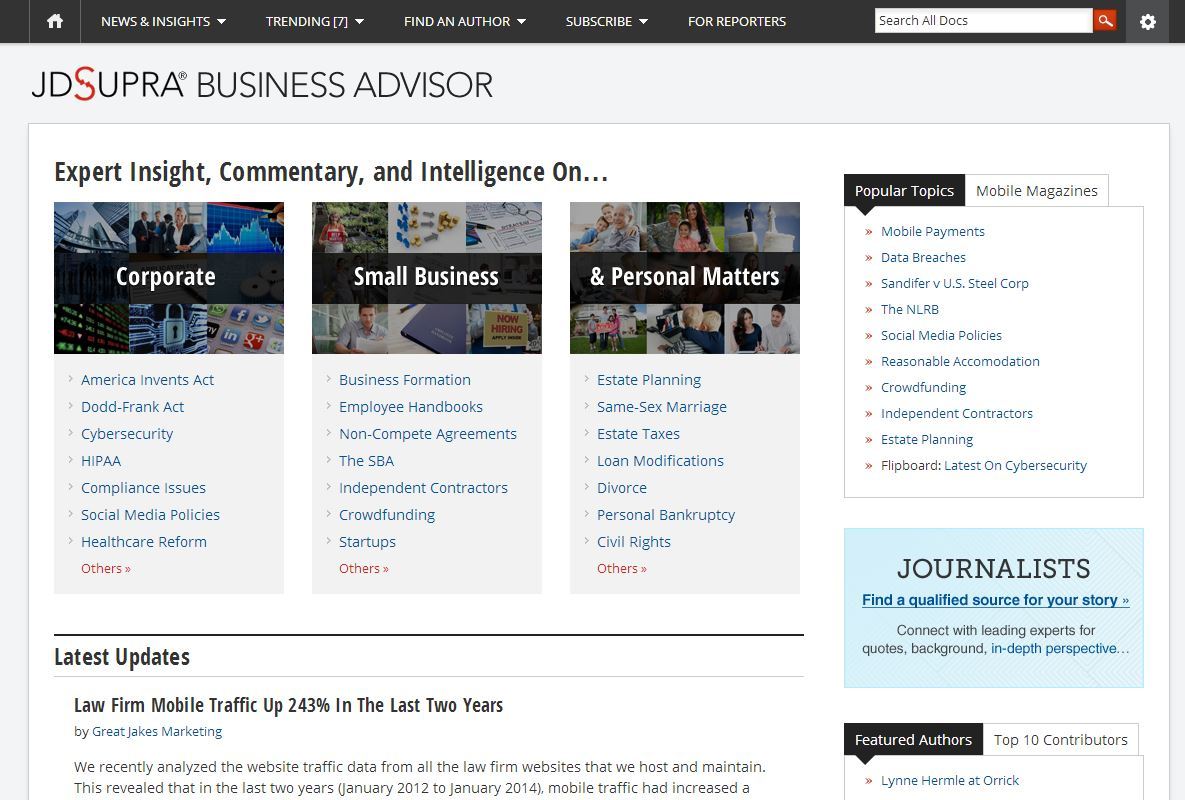Without any fanfare, JD Supra changed its tagline last month, to “JDSupra Business Advisor.” The move emphasizes the company’s evolution from a simple aggregator of law-related content to a publisher, distributor and curator focused on delivering legal information to the business world.
When JD Supra launched in 2008, its original tagline was, “Give Content. Get Noticed.” Back then, it was primarily a document-sharing site, a place where lawyers could post documents of any kind — court filings, decisions, forms, articles, alerts or newsletters — and make them available to the public. The site promoted itself to consumers to search for legal information and to members of the media to search for story ideas or sources.
Over time, JD Supra began to organize all that content by practice areas and areas of interest, and then to push some of that content out. To reflect those developments, it changed its tagline at some point to “JDSupra Law News.” In 2009, it started pushing topical content out via Twitter. Then, in 2010, it took a giant step forward through a partnership with LinkedIn that let LinkedIn users receive Legal Update feeds of JD Supra content targeted to a user’s particular interests.
Last year, LinkedIn discontinued third-party applications such as JD Supra, but JD Supra had already started building out a wider array of content-distribution vehicles. As it did that, it also sharpened its focus on the business world as its audience and on law firms that cater to that audience as its content providers. “The audience is the business world,” Aviva Cuyler, JD Supra’s founder and CEO, told me recently. “We’re a vehicle for the legal world to reach that audience.”
Now, JD Supra has a number of topical feeds for news, updates and analysis. The feeds can be followed via email, Twitter, RSS, through blogs, on Facebook or via JD Supra’s iPhone app. “Our distribution has grown to include corporate counsel, directors and executives — the audiences that business firms want to reach,” Cuyler said.
Beyond distribution, JD Supra has also branched out into other related areas:
- Publisher feeds. Publishers can embed feeds of law news and updates from JD Supra tailored to their readers’ interests. One example of a publisher that incorporates JD Supra content is Today’s General Counsel.
- Resource centers. Legal and business associations now use JD Supra to power resource centers for their members. These are branded to the association but driven by JD Supra. Two organizations that have these behind their membership walls are DRI and the Society of Corporate Secretaries and Governance Professionals.
- Email newsletters. JD Supra now helps associations create email newsletters for their members. These are branded to the association but populated with JD Supra content.
The bulk of its content comes from the law firms and vendors that contribute their articles, blog posts, commentary, or whatever. However, as it has developed these initiatives, JD Supra has also become more active in helping to create content itself. Recently, for example, it started a perspective series, where its editors solicit perspectives on a timely topic from various sources.
So why would a law firm or legal vendor distribute its content through JD Supra if it already has its own blogs and newsletters? Cuyler’s answer to that is that JD Supra engages readers and builds audiences in ways direct distribution does not. Its readers have selected to receive its news feeds — they are interested in the content. Plus, the content is delivered in a “vendor neutral” way, so that it does not appear to be self-serving.
“We’re not just publishing their work, we’re driving engagement,” Cuyler said. And JD Supra actively monitors that engagement, providing analytics on readership and distribution of specific content that is far more granular than they could get through a tool such as Google Analytics. JD Supra also provides alerts to firms on what topics they should be writing about, based on the topics that are trending among its readers.
Something else that has changed about JD Supra over the years is its price. When it started, any lawyer could create a profile and post content for free. That is no longer the case. Now, only paid contributors are able to add content. Cuyler would not give me a specific price, saying it is customized to each contributor. Factors considered in setting the price include the amount of content, the locations of the content, and the formatting required to fit the content within JD Supra’s specifications.
You can see from perusing the site that a number of major law firms distribute their content through JD Supra, so clearly they believe they are getting value for whatever they pay.
“Content is perceived differently when it comes through a source such as JD Supra, as opposed to directly from the firm,” Cuyler said. “We see lawyers at competing firms sharing each others’ content when they see it coming out of JD Supra.”
 Robert Ambrogi Blog
Robert Ambrogi Blog